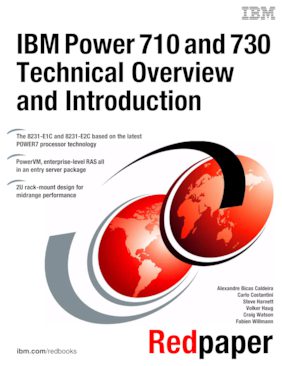IBM Power 710 and 730 (8231-E1C, 8231-E2C) Technical Overview and Introduction
An IBM Redpaper publication
Note: This is publication is now archived. For reference only.

Published on 19 November 2011, updated 13 December 2012
ISBN-10: 0738451169
ISBN-13: 9780738451169
IBM Form #: REDP-4796-00
Authors: Scott Vetter, Alexandre Bicas Caldeira, Carlo Costantini, Steve Harnett, Volker Haug, Craig Watson and Fabien Willmann
This IBM® Redpaper™ publication is a comprehensive guide covering the IBM Power 710 (8231-E1C) and Power 730 (8231-E2C) servers supporting IBM AIX®, IBM i, and Linux operating systems. The goal of this paper is to introduce the innovative Power 710 and Power 730 offerings and their major functions, including these:
Professionals who want to acquire a better understanding of IBM Power Systems products can benefit from reading this paper.
This paper expands the current set of IBM Power Systems documentation by providing a desktop reference that offers a detailed technical description of the Power 710 and Power 730 systems.
This paper does not replace the latest marketing materials and configuration tools. It is intended as an additional source of information that, together with existing sources, can be used to enhance your knowledge of IBM server solutions.
Chapter 1. General description
Chapter 2. Architecture and technical overview
Chapter 3. Virtualization
Chapter 4. Continuous availability and manageability